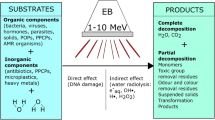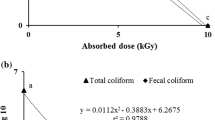Abstract
Sewage is the wastewater discharged from domestic premises consisting mainly of human waste. Sewage typically contains more than 99.9% water and about 0.05% solid. The solid part results in the formation of sludge. Largely, sludge is disposed in an unorganized manner resulting in environmental pollution and spread of diseases. The sludge produced carries a heavy microbiological load including pathogens and therefore its disposal has been a challenge to the urban development authorities. Indian cities and towns together are generating an estimated sewage load of 38,254 million liters per day (MLD), out of which 11,787 MLD is treated at sewage treatment plants (STP) with a capacity gap of 26,737 MLD (Ministry of Urban Development 2013). Considering 0.05% solid content, the total potential of sludge generation from the sewage is 19,127 tons per day. High energy ionizing radiation technology has a great potential for hygienizing municipal sewage sludge and makes it safer for use or disposal. In this study, dry sludge hygienization process was studied and compared with wet sludge hygienization. Dry sludge in plastic bags was hygienized in a terminal process using standard fully automatic irradiation plant without manual intervention. Dry sludge containing 75–80% solid irradiated at an average dose of 8 kGy, showed the absence of indicator organism E. coli/total coliforms even after 10 months of study period. Heavy metal concentrations in the domestic sewage sludge were observed to be much below the United States Environmental Protection Agency (US EPA) and Ministry of Urban Development, New Delhi (MOU) norms (Ministry of Urban Development 2013; United States Environmental Protection Agency). Inoculation of the hygienized sludge with Rhizobium, Azotobacter, and Phosphate solubilizing bacteria showed 100–1000 times higher growth in comparison to growth in unhygienized sludge. A comparison between dry and wet sludge (4–6% solid) irradiation shows that it is more practical to hygienize dry sludge which is economical, reliable, and scalable to treat 100–500 tons of city dry sludge. Use of radiation technology for sludge hygienization can significantly contribute to “Clean India Mission”. The technology is available with the department.
Access provided by CONRICYT-eBooks. Download conference paper PDF
Similar content being viewed by others
Keywords
- Sewage sludge
- Dry sludge
- Wet sludge
- Gamma radiation
- Radiation hygienization
- Pathogens
- Microorganisms
- Radiation dose
- Over dose ratio
Introduction
STP-generated dry sludge contains heavy load of bacterial counts including pathogens which could vary between 105 and 109 per gram. Sludge carries other life forms like worms, ova, viruses, helminthes, weeds, etc. It contains toxic heavy metals and organic pollutants like pesticides, polyaromatic hydrocarbons, drugs, and other persistent pollutants. Sludge is also a rich source of many macro- (Nitrogen, Phosphorous, Potassium), and micro-nutrients (Zinc, Iron, Copper, Manganese) and organic carbon essential for soil. Hygienized sludge can be gainfully used for agriculture, road side plantation, forestry, city home plants, etc. Ionizing radiation like gamma rays from cobalt-60 and electron beam from accelerator can be employed to deliver sufficient radiation dose to sludge to inactivate all life forms in the sludge and hygienize it (International Atomic Energy Agency 2002). The sewage sludge can be treated by two methods: (1) Wet sludge Irradiation (4–10% solid content, 96–90% water) and (2) Dry Sludge Irradiation (~75–80% solid, 25–20% water). The end product of both the process is dry solid cake.
Experimental
Plastic bags were filled with dry sludge (25 kg each) from drying beds of the STP and irradiated in a standard irradiator with conveyor system having about 700 kCi Cobalt-60 source. Ceric-cerous sulfate dosimeters and microbiological dosimeters were placed at minimum and maximum dose positions inside the bags and were sealed. Electrochemical method was used to evaluate absorbed radiation dose. Absorbed dose measurement and microbiological studies were carried out as per standard procedures (Gautam et al. 2005). The process of wet sludge hygienization is described elsewhere (Gautam et al. 2005). Reported values are an average of three readings. Microbiological indicator disks containing 1 × 106 spores of Bacillus pumilus ATCC14884 and Ceric-Cerous Sulphate Dosimeters were obtained from Board of Radiation and Isotope Technology (BRIT).
Results and Discussion
The quality of sludge (dry, semi-dry, or wet sludge) is determined by three factors namely (a) the presence of pollutants (arsenic, cadmium, chromium, copper, lead, mercury, nickel, selenium, and zinc. (b) The presence of pathogens (e.g., bacteria, viruses, parasites) and (c) The sewage sludge attractiveness to vectors, e.g., rodents, flies, mosquitoes, birds, etc.(United States Environmental Protection Agency). The process followed by STPs and determination of heavy metals could help in checking the suitability of sludge for use. In wet sludge irradiation, at 3–5 kGy dose, a larger portion of energy is consumed by water (96%) and output of dry sludge is only 4%, as well as the irradiator would require large quantity of Cobalt-60 and thus making economics unfavorable. Irradiation of dry sludge containing about 80% solid at an average dose of 8–10 kGy gave 20 times more output and lower radiation source requirement per kg of hygienized sludge produced. The results of microbiological investigations on irradiated dry sludge are given in Table 1. US EPA recommends use of treated sludge within 8 h of pathogen reduction process to overcome regrowth issue (United States Environmental Protection Agency). Hygienized dry sludge in plastic bags did not show increase in E. coli/total coliforms even after 10 months of study period. Reduction by about four log cycles of high radiation-resistant B. pumilus in the microbiological indicator (Table 1) demonstrates efficacy and reliability of radiation treatment for hygienization of dry sludge.
The results of inoculation studies showed 100–1000 times more growth of useful bacteria in the hygienized sludge in comparison to unhygienized sludge. The US/EPA requirements of heavy metals and microorganisms are given in Table 2. The heavy metal concentration in domestic sewage (Collected at SHRI facility, Vadodara) was observed to be much lower than the norms and therefore can be applied to land. Irradiation degrades toxic chemicals and does not alter the heavy metal concentration in the sludge (International Atomic Energy Agency 2002). On meeting the norms, the hygienized sludge can be safely applied on land applications. The radiation technology for dry sludge hygienization is available with the department.
References
Gautam S, Shah MR, Sabharwal S, Sharma A (2005) Gamma irradiation of municipal sludge for safe disposal and agricultural use. Water Environ Res 77(5):472–478
Irradiated sewage sludge for application to cropland, IAEA-TECDOC–1317, International Atomic Energy Agency (October 2002) pp 1–3
Manual on sewerage and sewage treatment system, Ministry of Urban Development, Part A, Page nos.- November 2013, New Delhi. (http://moud.gov.in)
United States Environmental Protection Agency (US, EPA), 40 CFR Part 503, Biosolid Rules
Acknowledgements
The authors acknowledge the support and encouragement given by Dr. Sekhar Basu, Director BARC, Dr. K.L. Ramakumar, Director RC&IG and Dr. A.K. Kohli, CE BRIT for developing Radiation Technologies for societal benefits.
Author information
Authors and Affiliations
Corresponding author
Editor information
Editors and Affiliations
Rights and permissions
Copyright information
© 2018 Springer Nature Singapore Pte Ltd.
About this paper
Cite this paper
Garg, N.K., Varshney, L. (2018). Gamma Radiation Technology for Hygienization of Municipal Dry Sewage Sludge. In: Singh, V., Yadav, S., Yadava, R. (eds) Energy and Environment. Water Science and Technology Library, vol 80. Springer, Singapore. https://doi.org/10.1007/978-981-10-5798-4_10
Download citation
DOI: https://doi.org/10.1007/978-981-10-5798-4_10
Published:
Publisher Name: Springer, Singapore
Print ISBN: 978-981-10-5797-7
Online ISBN: 978-981-10-5798-4
eBook Packages: Earth and Environmental ScienceEarth and Environmental Science (R0)




